6 Zendesk Alternatives & Competitors for 2025
The market for support, ticketing, and helpdesk tools is as crowded as it has ever been. However, it also presents a huge degree of internal variation, with different vendors targeting a range of granular use cases, organizations, and market segments.
Zendesk is one of the best-known players in this space.
It’s a popular choice as a modern, reliable, cloud-based support solution. However, it’s not necessarily the right fit for every team.
For instance, some competitors offer more flexibility and customization. Other vendors might be more cost-effective for certain use cases or better optimized for particular applications.
Today, we’re cutting through the noise by diving deep into the top Zendesk alternatives from across the market. Specifically, we’ll be covering:
Let’s start with the basics.
What is Zendesk?
Launched all the way back in 2007, Zendesk is a comprehensive suite of tools for helping businesses digitalize and manage customer and support interactions.
At its core, Zendesk aims to help teams to centralize and coordinate a whole range of service workflows, including managing customer service, sales, internal services, or any other service interaction.
This includes multi-channel support, tools for creating AI agents, self-service portals, traditional helpdesk features, and a huge marketplace of third-party apps.
Although it offers products for other use cases, Zendesk is still primarily aimed at the customer service and support corner of the helpdesk market. So, for other use cases, like IT or request management, other platforms might be better optimized for your needs.
That leads us to…
Why look for a Zendesk alternative?
Any software procurement decision draws on a range of factors across technical requirements, the resources you have available, and suitability for your end users. Let’s check out some of the key reasons you might consider one of Zendesk’s competitors.
Zendesk is generally pretty affordable, starting at just $19 per agent per month for basic support desk functionality. However, it has a slightly more complex pricing structure, with a variety of tiers for support use cases, as well as the wider service suite. Each of these has varying levels of feature restrictions. So, in some individual cases, you might need to upgrade to a more expensive license for specific pieces of functionality. Like most platforms in this space, Zendesk primarily charges on a per-agent basis. This is the norm since it’s a highly scalable approach for most applications. However, in certain cases, you might want to consider vendors with other models. For example, if you need to deploy a relatively simple ticketing solution to a large number of agents. As we noted, Zendesk covers a range of use cases, but it’s primarily optimized for customer-facing situations. Although there is a corresponding internal services platform, this is more focused on HR and other non-technical business lines. So, if you’re looking for specific functionality for the likes of IT, ops, or other more granular use cases, you might want to look elsewhere. Zendesk is fully cloud-based. For many teams, this is the right option, offering a hassle-free, scalable way to roll out a service management solution. However, for other teams, self-hosting is a firm requirement. This comes down to two things. Firstly, service data can be highly sensitive, so organizations prefer to manage this on their own infrastructure. The other is that self-hosting can provide a greater degree of control over things like security protocols, integration with other systems, or how we maintain a solution.Cost
Customer service-focus
Self-hosting
6 Zendesk alternatives for 2025
As we hinted at earlier, we’ve selected a range of options from across the market for ticketing, service, helpdesk, and support solutions. This includes some of Zendesk’s direct competitors, along with vendors that take a slightly different approach to the same underling pain points.
These are:
Here’s a summary of what each platform offers.
 Zendesk |  Budibase | Jira |  ServiceNow |  FreshDesk |  SalesForce |  Zoho Desk | |
|---|---|---|---|---|---|---|---|
| Platform Type | Service Management | Low-Code | Service Management | Service Management | Service Management | Service Management | Service Management |
| Pricing Model | Per-agent | Per-user/creator + Creator-only | Per-agent | Custom | Per-agent | Per-agent | Per-agent |
| Cloud | Yes | Yes | Yes | Yes | Yes | Yes | Yes |
| Self-Hosting | No | Yes | Yes | Yes | No | No | No |
| SSO | Paid plan | Free | Paid plan | Paid plan | Free | Paid plan | Paid plan |
| Open-Source | No | Yes | No | No | No | No | No |
| Query external DBs | No | Yes | Yes | Yes | No | Yes | Yes |
| API | Yes | Yes | Yes | Yes | Yes | Yes | Yes |
1. Budibase
First up, we have Budibase, the open-source, low-code platform that empowers teams to turn data into action.
Features
Budibase offers market-leading connectivity for external data sources. We offer support to build custom applications on top of all kinds of RDBMSs, NoSQL tools, APIs, spreadsheets, and more.
Simply connect your data, define roles and permissions, and autogenerate UIs. Our fully visual design tools enable IT professionals of all kinds to ship secure, custom applications with minimal custom code.
We also offer fully custom RBAC, free SSO, optional self-hosting, air-gapped deployments, and much, much more.
Use cases
Teams in all kinds of industries choose Budibase to build ticketing systems, approval apps, request workflows, forms, self-service portals, and all manner of other internal tools in a fraction of the time.
Budibase is also fully optimized for security-first teams. Our unique visual RBAC editor is the perfect tool for creating and managing user roles, ensuring colleagues have access to the exact data they need.
We also offer extensive workflow automation capabilities, including third-party integrations, branching/looping logic, and a huge range of triggers and actions. Our automation editor is ideal for triaging, categorization, and communications tasks.
Pricing
Budibase offers highly scalable pricing for teams of all sizes. You can build as many apps as you need for up to five authenticated users in the cloud or twenty if you self host - for free.
Premium licenses bill at $5 per month for end users and $50 for app creators. This also introduces custom branding, reusable code snippets, Budibase AI, and more.
Novelly, we offer creator-only pricing for enterprise customers. That way, you only pay for the colleagues who create Budibase applications with unlimited end users. Enterprise customers can also access air-gapped deployments, custom AI configs, enforceable SSO, and more.
2. Jira Service Management
Jira Service Management is Atlassian’s offering in the service desk niche. You might also like our guide to the top Jira Service Management alternatives .
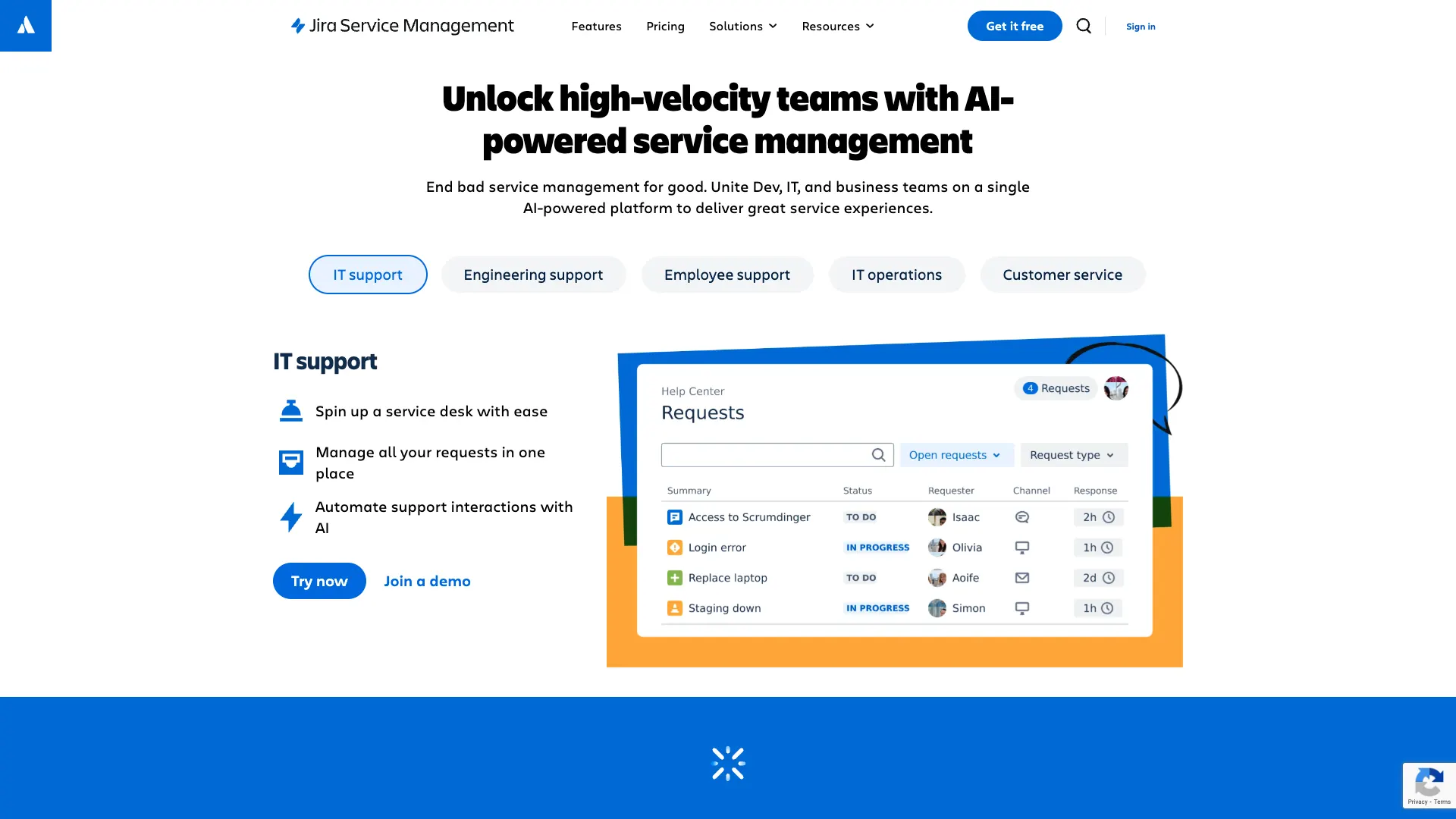
(Atlassian Website)
Pros
JSM is a strong offering for teams that need a robust service management solution that combines configurability with relatively easy implementation. We can easily set up custom workflows and ticketing processes, without writing custom code.
It offers some impressive out of the box workflows in the form of templates. These cover a diverse range of use cases, across ITSM requests, HR, marketing, customer services and more.
As you’d expect, JSM is uniquely well-integrated with the wider Atlassian ecosystem. For example, we can use Confluence for knowledge management or Jira for managing projects. This can be massively beneficial if you’re already embedded in the Atlassian suite of tools.
Cons
However, compared to Zendesk, JSM also presents some potential disadvantages. While not to the same extent as some other platforms, JSM takes a decent amount of configuration, whereas Zendesk might offer a faster time to value.
Additionally, although it’s a viable option in a wide range of contexts, Jira is most popular for IT use cases. Even more granularly than that, it’s generally optimized for Agile or DevOps teams. So, it’s not necessarily the obvious choice for general customer service.
Despite being a primarily visual experience, some users also report that they find configuring JSM for their own internal workflows a little bit counterintuitive.
Pricing
From a pricing perspective, Jira is quite an attractive offering. There’s a highly usable free tier, offering core functionality for up to three service agents. This also comes with an embedded knowledge base and templates for key use cases.
Paid licenses start from $23.80 per agent per month, with sliding discounts for additional seats. However, there are still feature restrictions here. For instance, we’ll need a Premium license to access virtual service agents or other AI features.
Custom enterprise licenses are also available, which bring along more advanced security and analytics capabilities.
3. ServiceNow
ServiceNow is undoubtedly the biggest name in the service management space. Although it’s best known as an ITSM platform, it also offers a direct Zendesk competitor in the form of ServiceNow CSM.
Take a look at our guide to choosing a ServiceNow alternative .
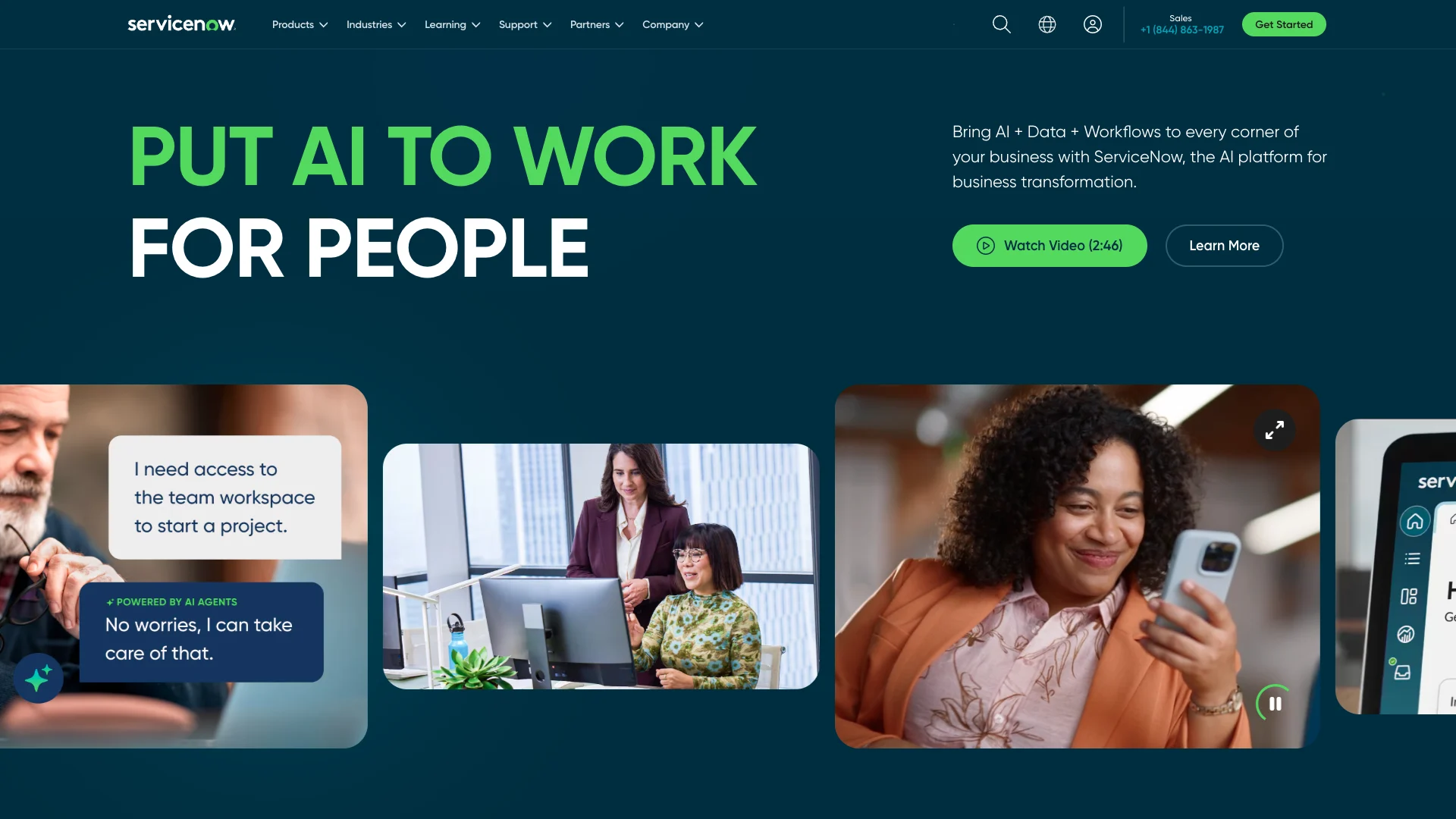 (ServiceNow Website)
(ServiceNow Website)
Pros
Like the wider ServiceNow platform, CSM is a great choice for enterprise use cases. As such, it offers an incredible scope for customization and configuration, making it ideally suited to more complex or far-reaching workflows.
It’s also one of the platforms with the most mature AI offering, including chat bots for handling end-user interactions, as well as predictive analytics tools for monitoring capacity, demand, and service levels.
ServiceNow is a very attractive proposition for teams that need extensive workflow automation capabilities, including a mixture of no/low-code and traditional automation tools, process mining functionality, and more.
Cons
The most widely reported downside of ServiceNow is the extensive work required to implement it. As such, it can present a comparatively high time to value, both in terms of rolling out a solution and training end users.
Additionally, ServiceNow’s clear enterprise focus might make alternative options more attractive to some smaller organizations. For instance, if you don’t need its more advanced functionality, ServiceNow might not be the best value for money.
Similarly, some users report that managing and maintaining workflows within ServiceNow requires a certain degree of learning curve, which not all teams will have the internal IT expertise for.
Pricing
ServiceNow pricing is not publicly available.
Rather, all quotes are customized for individual organizations based on their specific needs. This can take account of factors including user volumes, specific required features, use cases, SLAs, and support arrangements.
Some organizations purchase directly through ServiceNow, while others use official partners. The cost of this must also be factored in.
4. FreshDesk
Among the Zendesk alternatives we’ve seen so far, FreshDesk is probably the most like-for-like competitor.
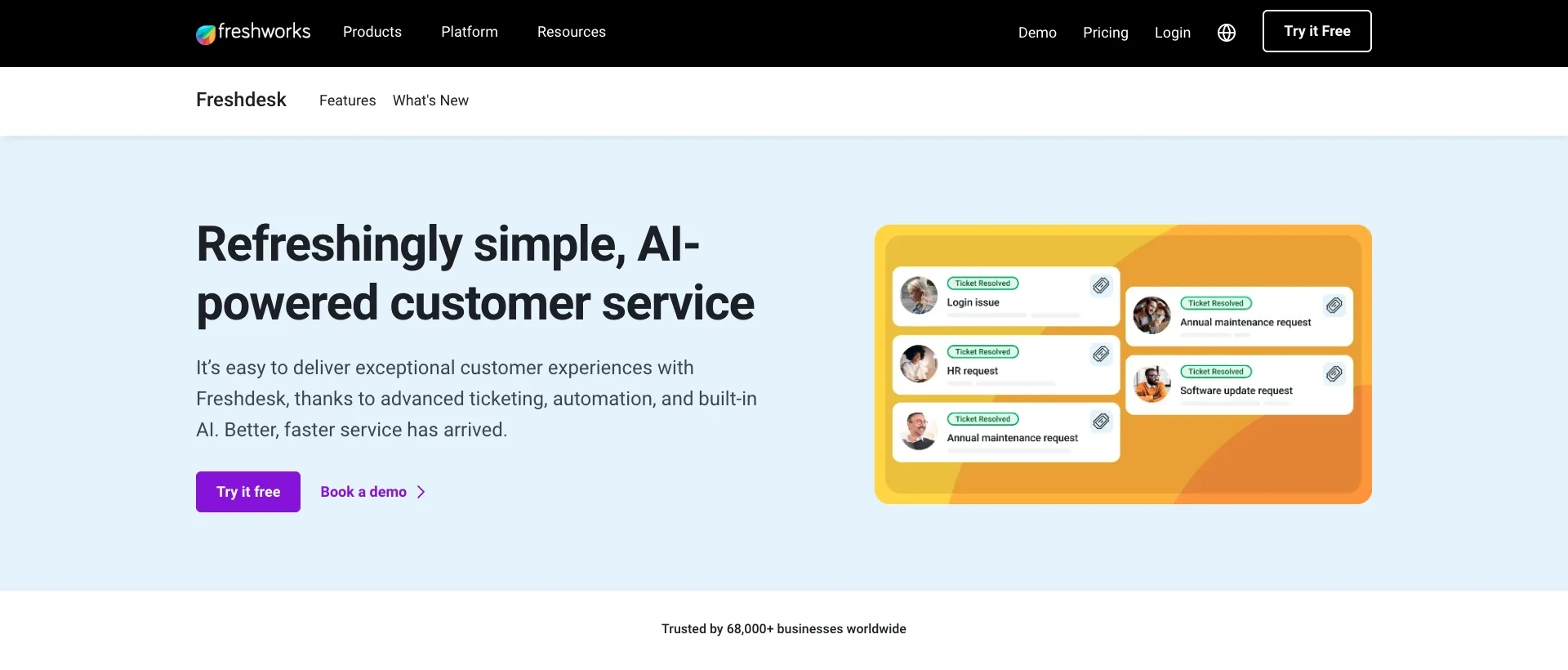 (FreshDesk Website)
(FreshDesk Website)
Pros
One of the areas where FreshDesk is strongest is UX. It’s an intuitive, modern feeling platform, that’s generally rated highly in terms of usability and ease of adoption. This applies both to end users and admins.
Like Zendesk, it requires minimal configuration. Rather, it’s aimed at teams that need a working solution out-of-the-box.
FreshDesk also offers great capabilities for teams that need to automate service workflows or integrate with their wider tool stack without necessarily having the IT resources to achieve this in more advanced platforms.
Cons
There’s always a tradeoff between ease of use and flexibility. So, compared to the likes of JSM or ServiceNow CSM, FreshDesk offers us less scope for customization or developing solutions that are bespoke to existing workflows.
Like Zendesk, FreshDesk is fully cloud-based. This means it can’t be self-hosted, so you’ll want to look elsewhere if this is a firm requirement.
Some larger organizations might also find that FreshDesk is harder to scale to large user volumes compared to more enterprise-focused solutions.
Pricing
For a basic ticketing system with a shared inbox, FreshDesk is free for up to two agents. However, it’s worth noting that this excludes most more advanced features.
Paid tiers start at $15 per agent per month, but it’s worth noting that we’ll need a Pro license at $35 for certain features, like approval workflows or AI assistants.
Enterprise licenses bill at $60 per user per month, making FreshDesk a highly affordable option with comparatively transparent pricing.
5. Salesforce Service Cloud
Service Cloud is Salesforce’s offering in the service management and helpdesk space.
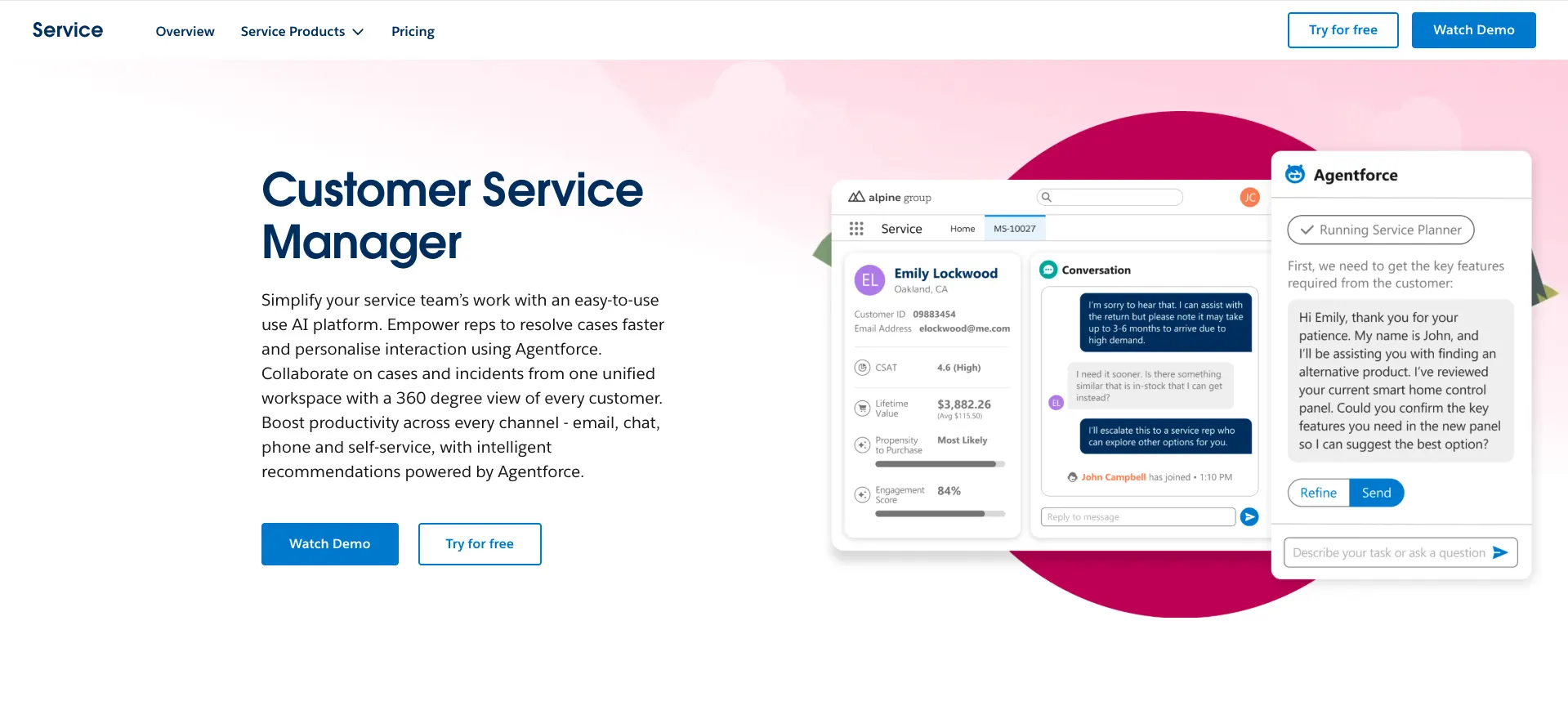 (SalesForce Website)
(SalesForce Website)
Pros
Salesforce’s platform is a customer service-focused, enterprise tool. So, we can expect a high degree of customization and extensibility. Notably, Salesforce also has one of the largest, most active communities of developers in this space.
It’s important to note that the wider Salesforce ecosystem is one of the most widely adopted CRMs in companies of all sizes. So, Service Cloud could be a natural choice if you’re in one of these organizations.
Developers also rate it highly, with Salesforce generally having a positive reputation for ease of use and configuration, including when configuring service workflows.
Cons
One potential downside of Service Cloud is that it’s primarily optimized for customer-facing tasks. This could make it an attractive direct competitor to Zendesk, but it could fall short of the likes of ServiceNow for more technical processes.
Like some of the other more configurable platforms we’ve seen, some users complain that Service Cloud takes a reasonably large amount of effort to get their workflows set up, compared to some simpler alternatives.
Salesforce is also a wholly cloud-based solution, so it doesn’t support self-hosting.
Pricing
Unlike some of the other platforms we’ve seen, there’s no free version of Service Cloud. Instead, paid licenses start from $25 per month.
Novelly, Service Cloud offers three distinct enterprise tiers with fixed prices, ranging from $165 to $500 per user per month.
We’ll need the most expensive of these to access the full complement of AI features as well as Salesforce Data Cloud.
6. Zoho Desk
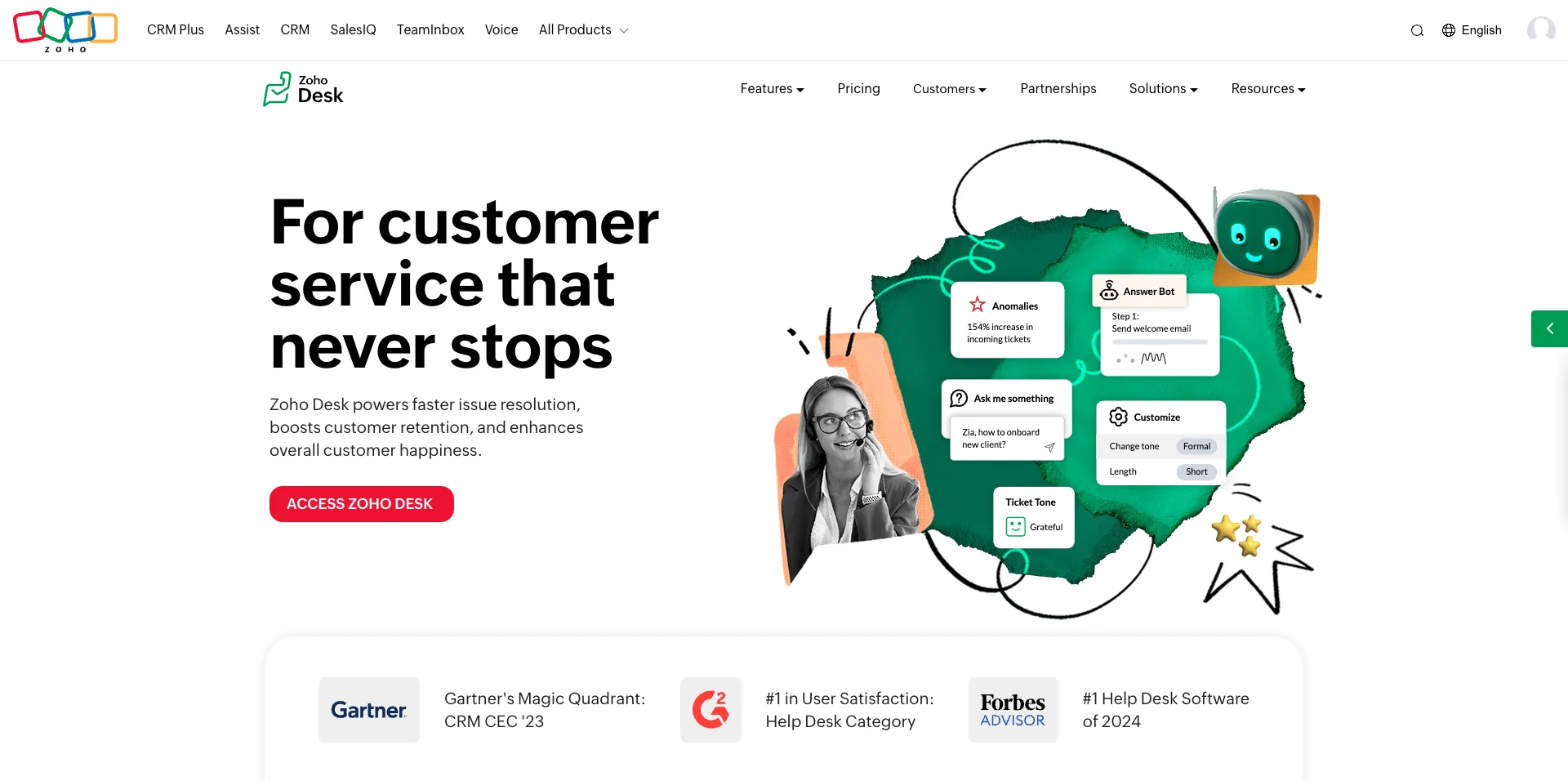
(Zoho Website)
Lastly, we have Zoho’s offering in the service management space - Zoho Desk.
Pros
Of all the platforms we’ve seen today, Zoho Desk is one of the best options for small to medium organizations. It’s one of the more affordable solutions out there, both in terms of raw pricing and the features that are available across tiers.
For example, it has some of the most generous offerings for AI functionality across cheaper price points. This could make it a great option for small teams that want to augment their human service agents.
It’s also highly integrated with the wider Zoho ecosystem, making it a great option for wider integration and workflow automation use cases without requiring extensive technical skills.
Cons
However, Zoho Desk might leave a little to be desired for enterprise use cases. For example, we can’t self-host it. We’ll also need more expensive licenses for certain key features, like skill-based ticket routing.
Another important consideration is that we might need other components of the Zoho Suite to achieve the same results as some of the other platforms we’ve seen - for example, if we want low-code apps or more powerful analytics in a service management platform.
Some users also complain that they face performance issues with Zoho, meaning that it may not be as suitable for larger-volume use cases.
Pricing
As noted earlier, Zoho Desk skews towards the SME end of the market for Zendesk alternatives. There’s a usable free tier, which offers core features for up to three users.
Paid plans start at just $7 per user per month, including some impressive capabilities, like workflows and custom domains.
Even the Enterprise tier is only $40 per user per month, including full AI functionality, multi-level IVR, and more.
Turn data into action with Budibase
Budibase is the fast, easy way to ship secure internal tools - with extensive external data support, autogenerated UIs, custom RBAC, powerful automations, optional self-hosting, and more.
Take a look at our features overview to learn more.